If you want to illustrate hierarchical relationships progressing vertically or horizontally, you can create a SmartArt graphic that uses a hierarchy layout, such as Labeled Hierarchy. A hierarchy graphically represents a series of ordered groupings of people or things within a system. By using a SmartArt graphic in Excel, Outlook, PowerPoint, or Word, you can create a hierarchy and include it in your worksheet, e-mail message, presentation, or document.
Important: If you want to create an organization chart, create a SmartArt graphic using the Organization Chart layout.

Note: The screenshots in this article were taken in Office 2007. If you have a different version, your view might be slightly different, but unless otherwise noted, the functionality is the same.
Create a hierarchy
-
On the Insert tab, in the Illustrations group, click SmartArt.

-
In the Choose a SmartArt Graphic gallery, click Hierarchy, and then double-click a hierarchy layout (such as Horizontal Hierarchy).
-
To enter your text, do one of the following:
-
Click [Text] in the Text pane, and then type your text.
-
Copy text from another location or program, click [Text] in the Text pane, and then paste your text.
Note: If the Text pane is not visible, click the control.
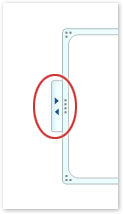
-
Click in a box in the SmartArt graphic, and then type your text.
Note: For best results, use this option after you add all of the boxes that you want.
-
-
Add or delete boxes in your hierarchy
Add a box
-
Click the SmartArt graphic that you want to add a box to.
-
Click the existing box that is located closest to where you want to add the new box.
-
Under SmartArt Tools, on the Design tab, in the Create Graphic group, click the arrow under Add Shape.

If you don't see the SmartArt Tools or Design tabs, make sure that you've selected the SmartArt graphic.
-
Do one of the following:
-
To insert a box at the same level as the selected box but following it, click Add Shape After.
-
To insert a box at the same level as the selected box but before it, click Add Shape Before.
-
To insert a box one level above the selected box, click Add Shape Above.
The new box takes the position of the selected box, and the selected box and all of the boxes directly below it are each demoted one level. -
To insert a box one level below the selected box, click Add Shape Below.
The new box is added after the other box at the same level.
-
Delete a box
To delete a box, click the border of the box you want to delete, and then press DELETE.
Notes:
-
When you need to add a box to your hierarchy, experiment with adding the box before, after, above, or below the selected box to get the placement you want for the new box.
-
Although you cannot automatically connect two top-level boxes with a line in the hierarchy layouts, such as Horizontal Hierarchy, you can imitate this look by adding a box to your SmartArt graphic and then drawing a line to connect the boxes.
-
To add a box from the Text pane:
-
Place your cursor at the beginning of the text where you want to add a box.
-
Type the text that you want in your new box, press ENTER, and then to indent the new box, press TAB, or to negative indent, press SHIFT+TAB.
-
Move a box in your hierarchy
-
To move a box, click the box, and then drag the box to its new location.
-
To move a box in very small increments, hold down CTRL while you press the arrow keys on your keyboard.
Change to a different hierarchy layout
-
Right-click the hierarchy that you want to change, and then click Change Layout.
-
Click Hierarchy, and then do one of the following:
-
To show hierarchical relationships progressing from top to bottom and grouped hierarchically, click Labeled Hierarchy.

-
To show groups of information built from top to bottom and the hierarchies within each group, click Table Hierarchy.
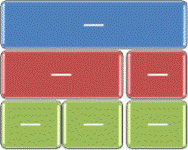
-
To show hierarchical relationships progressing across groups, click Hierarchy List.
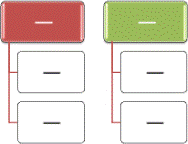
-
To show hierarchical relationships progressing horizontally, click Horizontal Hierarchy.
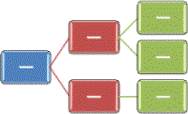
-
To show hierarchical relationships progressing horizontally and labeled hierarchically, click Horizontal Labeled Hierarchy.
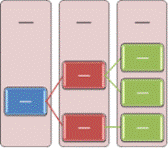
-
Note: You can also change the layout of your SmartArt graphic by clicking a layout option in the Layouts group on the Design tab under SmartArt Tools. When you point to a layout option, your SmartArt graphic changes to show you a preview of how it would look with that layout.
Change the colors of your hierarchy
To quickly add a designer-quality look and polish to your SmartArt graphic, you can change the colors or apply a SmartArt Style to your hierarchy. You can also add effects, such as glows, soft edges, or 3-D effects.
You can apply color combinations that are derived from the theme colors to the boxes in your SmartArt graphic.
-
Click the SmartArt graphic whose color you want to change.
-
Under SmartArt Tools, on the Design tab, in the SmartArt Styles group, click Change Colors.

If you don't see the SmartArt Tools or Design tabs, make sure that you've selected a SmartArt graphic.
-
Click the color combination that you want.
Tip: When you place your pointer over a thumbnail, you can see how the colors affect your SmartArt graphic.
Change the color or style of a line
-
In the SmartArt graphic, right-click the line or box border you want to change, and then click Format Shape.
-
To change the color of the box's border, click Line Color, click Color
 , and then click the color that you want.
, and then click the color that you want. -
To change the style of the box's border, click Line Style, and then choose the line styles you want.
Change the background color of a box in your hierarchy
-
Right-click the border of a box, and then click Format Shape.
-
Click the Fill pane, and then click Solid fill.
-
Click Color
 , and then click the color that you want.
, and then click the color that you want. -
To specify how much you can see through the background color, move the Transparency slider, or enter a number in the box next to the slider. You can vary the percentage of transparency from 0% (fully opaque, the default setting) to 100% (fully transparent).
Apply a SmartArt Style to your hierarchy
A SmartArt Style is a combination of various effects, such as line style, bevel, or 3-D, that you can apply to the boxes in your SmartArt graphic to create a unique and professionally designed look.
-
Click the SmartArt graphic whose SmartArt Style you want to change.
-
Under SmartArt Tools, on the Design tab, in the SmartArt Styles group, click the SmartArt Style that you want.

To see more SmartArt Styles, click the More button
 .
. If you don't see the SmartArt Tools or Design tabs, make sure that you've selected a SmartArt graphic.
Notes:
-
When you place your pointer over a thumbnail, you can see how the SmartArt Style affects your SmartArt graphic.
-
You can also customize your SmartArt graphic by moving boxes, resizing boxes, adding a fill or effect, and adding a picture.
Animate your hierarchy
If you're using PowerPoint, you can animate your hierarchy to emphasize each box, each branch, or each hierarchical level.
-
Click the SmartArt graphic hierarchy that you want to animate.
-
On the Animations tab, in the Animations group, click Animate, and then click By branch one by one.

Note: If you copy a hierarchy that has an animation applied to it to another slide, the animation is also copied.
No comments:
Post a Comment